
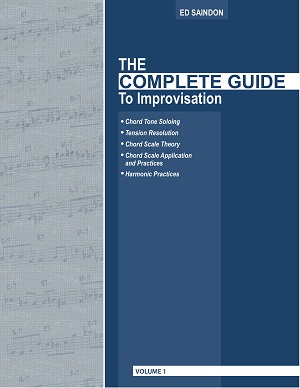
|
The Complete Guide To Improvisationby Ed SaindonThe Complete Guide To Improvisation codifies and explains the principal concepts and techniques used by leading improvisors past and present.
Volume One (162 pages)
Chapter 1 - Chord Tone Soloing This is an important and fundamental approach to improvisation. The technique involves only using chord tones as a means of note selection. The challenge lies in the fact that chord tones are stable notes. Topics addressed in this chapter include: use of motives, editing, phrasing, suggested exercises, guide tone lines, chord tone solos with designated intervals and chord tone solos on well-known standards. Chapter 2 - Tension Resolution Tension Resolution (TR) allows the improvisor to utilize any twelve notes over a chord. TR prevents stagnation in the melodic line as the constant back and forth of tension and release keeps the line moving. The Tension Resolution Principle: Chord tones are stable notes that outline and sound the harmony. Any notes other than chord tones create tension, which can be resolved up or down to an adjacent chord tone. Along with chord tones, any non-chord tone may be sounded during a measure and resolved to an adjacent chord tone at some point in the measure. Non-chord tones fall in the categories of Passing, Approach and/or Tensions. The following TR techniques are addressed in this chapter:
Also addressed in this chapter: step by step method for creating solos based upon Tension Resolution and written out solos (using TR) on well-known standards. Chapter 3 - Chord Scale Theory The application of chord scales in improvisation is an important topic since many improvisational techniques such as the use of Upper Structure Triads and 7th chords, Four Note Groupings, Intervallic Playing and Pentatonics are chord scale based. The chapter begins by listing available chord scales based upon every chord type. The chapter addresses the many options of chord scales along with the criteria for choosing a specific scale over a chord. Criteria addresses chord scale selection in the both the context of conventional and non-conventional harmony. The Advanced Chord Theory Section addresses more advanced scale options such as cross-referenced scales, synthetic scales (including Double Harmonic Major, Double Harmonic Minor and Symmetrical Tritonic), Hexatonic and Ethnic/Exotic scales. Chapter 4 - Chord Scale Application and Practices Ways of practicing chord scales as well as various application techniques in using chord scales will be addressed in this chapter. While it is important to have knowledge of chord scales, the techniques of how chord scales are applied are crucial in effective improvisation. Too often, improvised solos sound like the soloist is randomly running up and down scales. The chapter addresses ways of practicing scales that will enable the improviser to better handle various application techniques of chord scales. Additional topics addressing the application of chord scales include Note Deletion, Adding Chromatic Notes, Note Deletion/Adding Chromatic Passing Notes, Change in Direction of the Line, Use of Space and Use of Syncopation. Additional topics covered in this chapter include: Practice Routines, Scalar Patterns, Use of Motives/Patterns and Breaking Down the Scale into Two Groups. Chapter 5 - Harmonic Practices A comprehensive and in depth knowledge of jazz harmony is indispensable to the improvisor. Many improvisational concepts are based on harmonic principles that allow the improvisor to deviate from the original underlying harmony of a standard tune progression. The application of these harmonic concepts as a means of creating lines results in chromatic lines that have a strong sense of logic and direction. Such players as innovator John Coltrane and pianists such as Herbie Hancock and Chick Corea have utilized advanced harmonic techniques in their lines. With Coltrane, we get his “sheets of sound” and advanced superimposed harmony. With players like Hancock and Corea, the harmony is altered, reharmonized and superimposed thereby creating lines that are intriguing as a result of the harmonic deviations. The utilization of these harmonic techniques are not relegated to the players of today. Sax players like Coleman Hawkins and Don Byas were using reharmonization and substitution in their solos. Pianist Art Tatum was a master with harmony, substitutions and reharmonization. Within the language of Be Bop, players like Charlie Parker and Sonny Stitt were using a variety of these harmonic devices on a consistent basis in their solos. Contemporary sax players such as Dave Liebman, Michael Brecker and Bob Berg have incorporated many harmonic techniques that have resulted in unique and interesting chromatic lines that weave in and out of the underlying changes. There are many concepts, techniques and topics on the subject of jazz harmony as well as many books that address jazz harmony. However, in this chapter we will limit our scope of jazz harmony to specific approaches and concepts that can be applied to improvisation. |
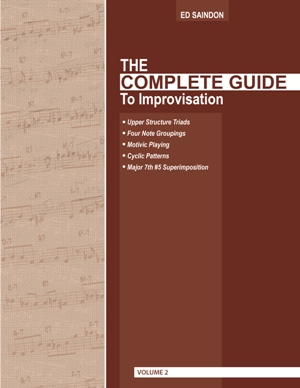
|
Volume Two (249 pages)
Chapter 1 - Upper Structure Triads Upper Structure Triads (USTs) are those triads which contain at least one tension in relation to the underlying chord structure. They are derived from a chosen scale. USTs enable the lines to sound unresolved tensions over the chord while at the same time providing a sense of logic and structure. The makeup of the triad allows the improvisor to use more unconventional scale choices and tensions as well as offering the opportunity to deviate from the underlying harmony. Topics in this chapter include: UST chart for all chord types, incorporating passing and approach notes with USTs, adding one note to USTs, creating lines with multiple USTs, USTs derived from the Symmetrical Diminished scale, UST patterns, USTs with unconventional tensions, Out of Scale USTs, sample UST solos on standards. Chapter 2 - Four Note Groupings Four Note Groupings (FNGs) is an improvisational technique based on the application of major and minor triads along with a specific passing note. These groupings function as lower, middle and upper structures and provide a means of generating melodic lines. Due to its triadic structural integrity the concept of FNGs can expand the availablity of notes over a chord, allowing the lines to sound more "out" if desired. An additional benefit of the FNGs concept is that the improvisor can work its system and characteristic sound without falling into the trap of playing licks and repetitive phrases. With many possible FNG choices, this broad concept creates a deep well for the improvisor to draw from. Topics in this chapter include: FNGs chart for all chord types, concepts in selecting FNGs, Approach notes in FNGS, Out of Scale FNGs, FNGs solos on many standards including Stella by Starlight, On Green Dolphin Street, Giant Steps and Rhythm Changes. Chapter 3 - Motivic Playing Motivic Playing is one of the most important and fundamental aspects of improvisation. Since the Baroque period, classical composers were/are adept in the application and development of motives used in creating themes and melodies. A motive can also be thought of as a particular melodic idea, shape, structure or pattern. With Motivic Playing, the initial idea can be repeated, developed and manipulated in a multitude of ways over a chord or progression. The use of motives along with their repetition, manipulation and development, lends a compositional approach to the improvisation creating lines which emerge and evolve out of the music in a natural way. Any melodic phrase that we play, whether it is two or ten notes, can be the basis of a motive. Other improvisational techniques such as Pentatonic scales, Four Note Groupings, Symmetrical Diminished Patterns, Upper Structure Triads and 7th Chords have the potential for generating strong motivic lines. As with the aforementioned techniques, Motivic Playing similarly offers the improvisor the opportunity to stretch in terms of sounding unusual notes and unconventional tensions. Additionally, a strong, identifiable motive allows the improvisor to select unusual chord scales. It also provides an opportunity to “play outside the changes” by moving the motive in and out of the chord scales of the underlying harmony. Topics in this chapter include: Motivic Categories, Motivic Manipulation, Two and Three Note Motives, Motivic Techniques and Concepts, Combining Cells to Create a Long Motive, Variations with a Motive. Chapter 4 - Cyclic Patterns “Playing outside the changes” refers to improvising with lines that deviate from the underlying chord structure and corresponding chord scale. This can be an effective approach in the creation of melodies that sound extended durations of dissonance tempered with resolution. The improvisational concept of Cyclic Patterns provides various ways for the lines to venture outside the tonality of the underlying harmony while retaining a sense of focus and logic. The concepts discussed in this section should be used carefully and with restraint since playing outside the changes excessively and without clear resolution can make the lines seem random and directionless. With the concept of Cyclic Patterns, a specific interval, scale fragment, motive, pattern, structure (triad, 7th chord, intervallic structure) or system (Pentatonic scale fragment, Four Note Grouping) can me shifted outside of the underlying chord structure via a specific repeating intervallic configuration. The improvisor has a large amount of freedom with regard to moving the aforementioned musical elements through a cycle. As will be demonstrated in some of the following examples, a chosen element does not have to be exactly replicated during such process. Applying subtle variations in rhythm and order of notes in the transposition of a motive can render the melodic line less contrived and more organic. However, it is important for the improvisor to use caution when applying these variations, since excessive use can lead to a vague motive. The examples in this chapter will illustrate some of the available options for moving an element out of the chord’s tonal center via a specific repeating interval. Topics in this chapter include: Ascending Three Note Motives, Pentatonic Scale Fragments, Triadic Exercise, Ascending Perfect Fourths, Symmetrical Diminished Four Note Motives, Ascending Major 3rd Motives, Cyclic Combinations, Extended Cyclic Patterns Chapter 5 - Major 7th #5 Superimposition The Major 7 #5 chord is a distinctive sounding chord structure that can be used as a means of generating unique melodic ideas. The superimposition of the structure is not limited to its harmonic relationship with the underlying harmony. In certain cases the application of the structure is chosen liberally, on the basis of sounding unconventional tensions and unusual notes. Some usages of the Maj 7 #5 structure offer the improvisor the option of utilizing related scales, such as the Symmetrical Augmented scale. This chord scale based application can help generate symmetrical lines containing a variety of chord types and patterns that are major 3rds apart. Topics in this chapter include: Major 7th #5 Superimposition Chart, Considerations in the Selection of Maj 7th 35 Chords, Chord Alteration, Techniques in using Maj 7th #5 Chords, Sample Solo on Stella By Starlight, Related Maj 7th #5 Scales, Passing and Diatonic/Chromatic Approach Notes, Superimposition Techniques with the Augmented Triad. |

|
Volume Three (241 Pages)
Chapter 1 - Upper Structure 7th Chords Similar to Upper Structure Triads, a 7th chord that contains one or more tensions over the underlying harmonic structure qualifies as an Upper Structure 7th chord (hereby listed as US7th). The structural integrity of US7th chords affords the improvisor the opportunity to explore more possibilities with regard to the sounding of conventional and unconventional tensions, tension resolution techniques and the application of various harmonic devices such as superimposition and side slipping. The US7th chord types addressed in this chapter include Maj 7, Maj 7 #5, Dom 7, Dom 7 sus 4, Min 7, Min 7 b5, Min Maj 7 and Dim 7. As a general rule, US7th chords should not contain avoid notes of the underlying chord. However, in some cases the improvisor may effectively select an US7th chord that contains an avoid or “wrong” note with the purpose of intentionally creating and resolving the dissonance. Topics in this chapter include: Advance Scale Concepts for deriving US7th Chords, US7th Chord Chart, Techniques with US7th chords, US7th Chord Alternated with Original Chord, US7th Chord Pairs, US7th Chord Pair Patterns/Exercises, Bop Lines Derived from US7th Chords, Harmonic Techniques with US7th Chords Chapter 2 - Pentatonic Scales A Pentatonic scale consists of five notes arranged in various intervallic combinations within the range of an octave. Scales of this type are widely distributed geographically and historically and have been used extensively by all prominent composers and improvisors in most musical genres. For the purpose of this study, the Pentatonic scale is used as an improvisational vehicle over any chord type, group of chords and chord progression. Its characteristic sound provides unity in the melodic line and allows for some “stretching” of the chord’s corresponding tensions. This improvisational technique also lends itself to the application of unconventional tensions and the possibility for harmonic deviation. Topics in this chapter include: Pentatonic Scale Chart, Practice Suggestions (Using Skips, Pentatonics within an Octave, Pentatonic Scale Connection), Application of Pentatonic Scales, Considerations Using Pentatonics, Techniques for Choosing Pentatonics, Approach Notes/Patterns, Incomplete Pentatonics, Solos Using Pentatonics (C Minor Blues, F Blues, Six Blues Choruses, Second’s Notice, There Will Always Be Another You, How Deep Is The Sea) Chapter 3 - Side Slipping The concept of Side Slipping is conducive to melodic material with brief or prolonged durations of dissonance tempered with resolution. The lines are able to go outside of the chord and related scale while retaining a sense of focus and logic. Side Slipping involves the transposition of melodic material and/or structures (scalar fragments, motives, triads/7th chords, intervals) and systems (Pentatonic scales, Four Note Groupings) to points outside of the scale of the underlying chord. This study of Side Slipping addresses the intervallic shift possibilities of a minor second (up or down) and tritone. Throughout the examples, the brackets indicate where the Side Slipping occurs. Topics in this chapter include: Minor 2nd and Tritone Shifts with Scalar Fragments, Motives, Triads, Upper Structure 7th chords, Specific Intervals, Pentatonic Scale Fragments and Four Note Groupings Chapter 4 - The Symmetrical Diminished Scale The Symmetrical Diminished scale is an eight-note scale most prevalently heard in the jazz improvisors’ musical vocabulary. Due to its symmetrical structure the scale is prone to the overuse of cliché phrases and common patterns. However, if used tastefully and creatively, the same structural attribute of the scale can provide an array of intricate melodic and harmonic color, making it a valuable tool in the improvisor’s arsenal. Topics in this chapter include: Symmetrical Diminished Theory, Scale Symmetry, Creating Patterns, Techniques for Creating Patterns, Symmetrical Diminished Scale Patterns, Additional Concepts for Patterns, Diatonic Chords in the Scale, Triad Pairs, Tritonic/Hexatonic Scales, 7th Chord Pairs, Pentatonic b2 Scale Chapter 5 - Symmetrical Diminished Superimposition While the common practice is to apply a specific Symmetrical scale over related Dim 7 and Dom 7 chords, any Dim 7 chord and corresponding Symmetrical Diminished scale can be superimposed over any type of underlying chord, progression or pedal point. The symmetry of the lines generated by the Diminished chord and related scale allows the improvisor to play outside of the underlying harmony, and enables the execution of assorted phrases, motives and shapes that can be transposed up or down in minor third intervals. Each superimposed Diminished chord and scale will function differently and may sound dissonant/avoid notes of a given underlying harmony. It is important for the improvisor to be aware of the harmonic and melodic implications presented by each Diminished superimposition. All avoid notes have the potential to be resolved to an adjacent chord tone in the scale or to a diatonic scale note of the underlying harmony. Topics in this chapter include: Superimposed Examples, Sample Lines for all Chord Types, Diminished 7th Superimposition Techniques, Pentatonic b2 Scale, Pentatonic b2 Scale Solo on Spring Leaves, Dim Maj 7th Superimposition, Triads in Minor Third Patterns, Exercises, Harmonic Practices, Diminished Scale Superimposition Techniques, Spring Leaves Solo Future Volumes:
Volume Four
|
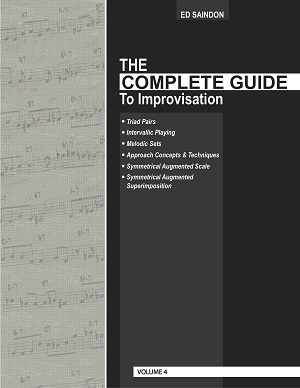
|
Volume Four
Chapter One - Triad Pairs This is an improvisational technique based upon the combination of two triads that do not share common tones. The concept of Triad Pairs affords the improvisor many possibilities with regard to the use of chromaticism and harmonic deviations, as well as the inclusion and emphasis of unconventional tensions. The structural integrity of the two triads lends the lines a sense of logic and harmonic motion. In addition, a Triad Pair yields a six-note scale known as Hexatonic, also addressed in this chapter. This study of Triad Pairs is limited to the selection of Major and Minor triads. The following chart lists the possible Triad Pairs according to various chord types. The pair is labeled according to how the roots of the triads relate to the underlying chord. For example, on a C Maj 7 chord, the Triad Pair of C Major and D Major is listed as 1/2. The Triad Pair of E Minor and A♭ Major is listed as 3-/♭6. Chapter Two - Intervallic Playing This linear concept of improvisation is based on the predominant use of a particular interval or combination of intervals. It has the potential of generating open, angular and engaging lines over chord progressions. Intervallic lines are typically recognized for seamlessly “floating” over the chord changes and bar lines. Their structural strength enables the improvisor to play notes out of the chord scale and resolve back into it. In constructing intervallic lines, the improvisor should strive to sound interesting tensions over the chord(s). Horizontal lines rich in tensions and unusual notes create appealing musical statements from a linear and vertical perspective. Chapter Three - Melodic Sets This linear improvisational technique consists of three to five-note pitch sets, which may combine chord tones, approach notes, and both conventional and unconventional tensions of the underlying chord(s). In addition to the specific note selection, the intervallic structure of the Melodic Set is also an important consideration. The set of notes can be played in any inversion when creating lines. Depending on the makeup of the pitch set, its inversions may produce either very scalar and/or angular lines. An important factor in the selection of notes for a Melodic Set is the sounding of harmonically rich and interesting notes of the underlying harmony. These notes may or may not have to be resolved in the line. While there are correlations between Melodic Sets and some other concepts in The Complete Guide To Improvisation, such as Four Note Groupings, Pentatonics, Upper Structure Triads and 7ths, this improvisational technique is less restricted and can consequently generate additional possibilities. Chapter Four - Approach Concepts & Techniques This chapter addresses the application of more complex approach techniques and concepts for creating lines. Conventional diatonic and chromatic approach techniques are discussed in the Tension Resolution chapter. Other material related to this topic can also be found in the Harmonic Practices chapter under Approach Chords. The focus of this section is on the usage of intervallic-based phrases, scale fragments, symmetrical patterns, and chord structures that resolve up or down a half step into an assigned target note (chord tone and/or available tension) of the underlying harmony. The expansion of conventional approach techniques provides more possibilities for prolonged tension, delayed resolution, chromaticism and color in the melodic line. A purposefully balanced resolution of dissonance along with a clear and clear execution of the techniques presented in this chapter, may strengthen and enhance the intention of a melodic statement. Chapter Five - Symmetrical Augmented Scale The Symmetrical Augmented scale is a unique sounding melodic device used by improvisors and composers alike. The scale’s symmetry, based upon the division of the octave into three equal parts, can generate interesting and unusual lines, rendering possible the transposition of its many diatonic chords and structures via major third intervals. The intervallic makeup of the scale, comprised of a minor third and half step repeated up in major thirds, results in four possible Chapter Six - Symmetrical Augmented Superimposition The criteria in the selection and application of the Symmetrical Augmented scale are fairly liberal. The first section of this chapter demonstrates how any of the four Symmetrical Augmented scales may be used over any chord type. The choice may be governed by several factors, such as the function of the chord the scale is to be applied to, musical and stylistic context, and the improvisor’s preference and intention. Some scale choices may reveal more dissonant notes over the underlying harmony. However, highly dissonant and/or “avoid” notes may be resolved to another note in the scale. The symmetry and unique architectural structure of the scale (alternated minor third and half step intervals), allow the improvisor to “stretch” and venture outside the underlying harmony by sounding unconventional tensions and unusual notes. It is therefore important for the improvisor to be aware of the harmonic implications (sounding of chord tones, conventional and unconventional tensions, dissonant, unusual and “avoid” notes) of any given Symmetrical Augmented scale over the underlying harmony. Such considerations, along with a creative and clear execution of motivic cells and patterns, will produce strong lines horizontally as well as vertically. |
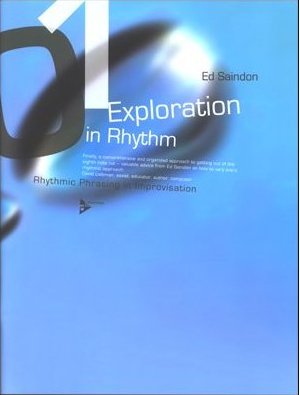
|
Exploration in Rhythm, Volume 1Rhythmic Phrasing in ImprovisationExploration in Rhythm, Volume 1, Rhythmic Phrasing in Improvisation is written for all instruments. Exploration in Rhythm was written to help develop and expand the rhythmic palette and vocabulary of the improviser and composer. The book focuses on playing “over the bar line” rhythms and long melodic phrases based upon rhythmic cycles that stretch over multiple measures. The material in the book has been used for Ed Saindon’s improvisation course at Berklee College of Music in Boston where he has been a professor since 1976. The book specifically addresses the concept of over-the-bar line phrasing via rhythmic groupings of 8ths, triplets, 16ths and polyrhythms in 3/4, 4/4, and 5/4. Working on these concepts, players should begin to “hear” rhythms that “float over the barline” as well as develop the ability to execute phrases over longer periods of time. The end result will be a sonic erasing of the bar line and an enhanced sense of freedom with regard to rhythm and phrasing.
|

|
Berklee Practice Method VibraphoneThis is a new book that I authored and was recently published by Berklee Press. It is being distributed by Hal Leonard. The book features a cd that contains some of my vibe solos which have been transcribed and are included in the book. The book is part of a series which was designed by Berklee College of Music faculty along with Dean of the Performance Division, Matt Marvuglio. This is the first-ever method that teaches you how to play in a rock band. Learn what all the great musicians seem to know intuitively—how to listen, interact and respond, improvise, and become part of the groove. The book and play-along CD will help improve your timing, technique, and reading ability. Become the great player that everyone wants to have in their band. Lessons throughout this book guide you through technique that is specific to playing vibraphone in a contemporary ensemble. When you play in a band, your primary concern is chords—how to read and play them, how to progress from one to the next, and how they interact with other instruments, melodically and rhythmically. Daily practice routines are designed for practicing by yourself or with other musicians. The accompanying CD features outstanding Berklee players and covers a variety of styles including rock, funk, jazz, blues, swing, and bossa nova. Topics Include:
This series coordinates methods for many different instruments, and all are based on the same tunes, in the same keys. If you know a guitarist, bassist, drummer, keyboardist, sax player, etc., have them pick up the Berklee Practice Method for their own instrument, and jam together! |

|
Voicing Concepts for the Jazz VibistAdvanced voicing concepts for the jazz vibist as applied to the II-7 V7 I Maj progression. Includes voicing concepts applied to the progressions of Autumn Leaves, Green Dolphin Street and Stella by Starlight as well as chord melodies to You Are Too Beautiful and But Beautiful. Knowledge of voicings is an important area for the jazz vibist. In this study we deal with more advanced and unusual voicing concepts for a common II-7 V7 I Maj 7 progression. Many of the voicings and voicing concepts come from pianists like Keith Jarrett, Herbie Hancock, Chick Corea, Brad Mehldau and Mulgrew Miller. Some of the topics include voicing concepts (for 3-6 note voicings) such as Symmetrical Diminished Shapes, Unusual Closed and Open Voicings. Voicings using Upper Structure Triads, Inner Line Movement, Intervallic Voicings, Clusters and much more. |
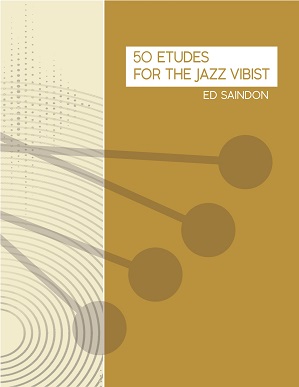
|
50 Etudes For The Jazz VibistThe etudes in the book are all based upon well-known standards and address a multitude of musical topics, concepts and techniques. Some of them were written with the purpose to show my students a specific improv concept, dampening technique, voicings, and various other subjects. Certain etudes are fairly easy while others are much more demanding. The vibist using the book is advised to play the etudes slowly at first in order to understand and assimilate the techniques and concepts being addressed in each etude. It is important for the vibist to follow up and apply the issues and concepts to other standards and possibly write out their own etudes. There are areas in the execution of the instrument that are still under developed and have a lot of untapped potential. Among them are the use and application of four-mallet playing and dampening techniques; especially in the area of one hand dampening techniques, which includes slide and pivot dampening. Some of the etudes in the book are focused on improv concepts such as chord tone connection, tension resolution, motivic playing and pentatonic scales, among others. I hope that vibists find these fifty etudes helpful in the course of understanding, working with and assimilating the concepts and techniques. They were deliberately written in my own hand as carefully, clearly and legibly as possible to add to the personal flavor of the book. For me, it is about furthering the development and level of vibraphone performance. It is also about passing on what I learned over the years from studying with Gary Burton and others, as well as my own research and development garnered from listening, studying, analyzing and assimilating the concepts and techniques demonstrated by all of the greats. |
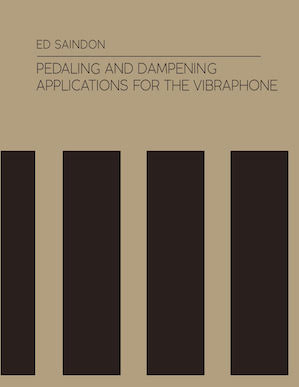
|
Pedaling and Dampening Applications for the VibraphoneThe vibraphone is a beautiful instrument that can be a challenge to play with nuance and expression. A vocalist, saxophonist or violinist has so much potential in terms of expressing various nuances and color. In contrast, the vibist is presented with pieces of metal from which to create music and emotion. In this regard, for the vibist, close attention and skill in pedaling and dampening techniques certainly help. The examples, etudes and solo pieces of songs in this book illustrate how the utilization of skillful pedaling and dampening can help the vibist play the instrument with more nuance and expression. The book covers in depth, two hand and one hand dampening techniques. One hand dampening techniques include slide, hand and pivot dampening. Other benefits in the use of pedaling and dampening techniques include: clarity when playing counterpoint; moving inner voices when playing voicings; playing the vibraphone as a pianist, with multiple lines and lines over voicings; clarity in arpeggiated accompaniment. In addition to exercises, etudes and song arrangements, the book addresses a wide variety of applications of pedaling and dampening techniques for playing solo pieces. It is important for the vibist not only to be able to execute specific dampening techniques, but also to handle the many possible applications on the spot, without working them out ahead of time. The ability to employ dampening in improvisation while executing an idea with spontaneity and complete control is essential. Since there are so many possible uses for dampening, it is important to work on exercises, etudes and classical pieces in order to appreciate those possibilities and assimilate the applications in a natural way. The material in the book also includes a wide array of classical pieces adapted for the vibraphone, various etudes on the blues as well as dampening applications applied to jazz standards such as "Stella by Starlight", "Autumn Leaves" and "All the Things You Are". |